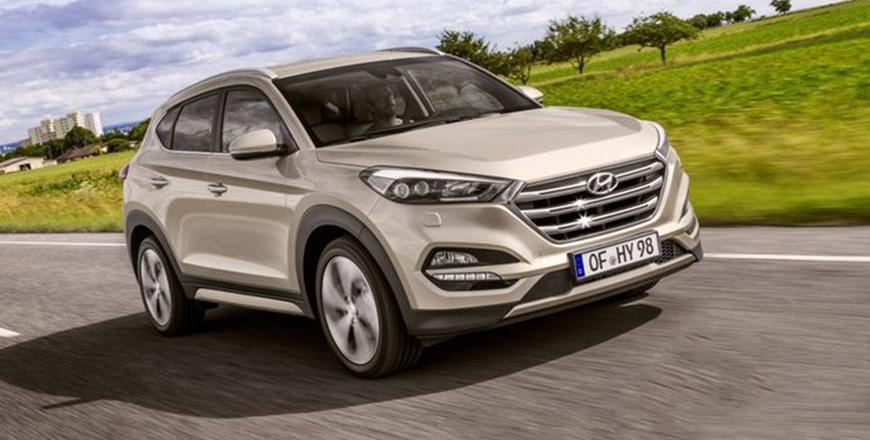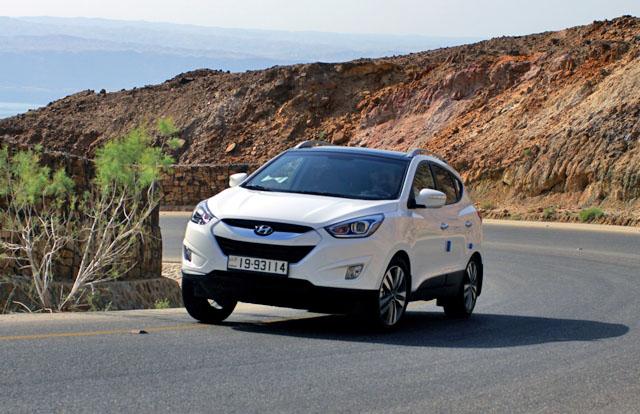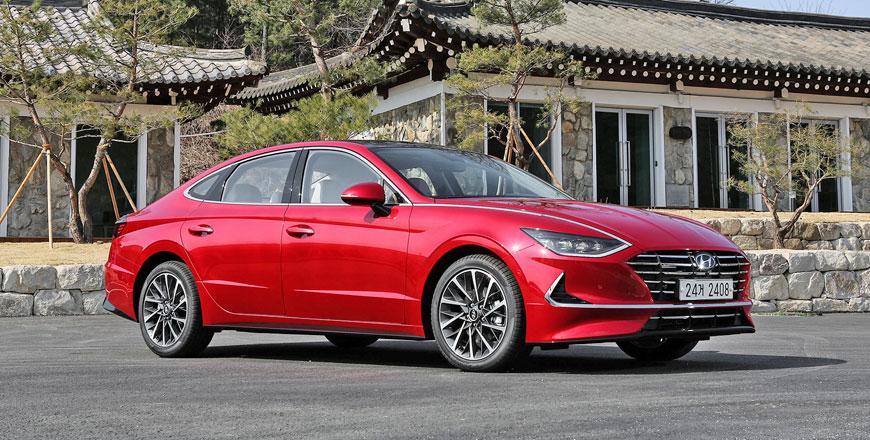You are here
Dramatic redesign and comprehensive improvement
By Ghaith Madadha - Oct 05,2015 - Last updated at Oct 07,2015

Photo courtesy of Hyundai
Already the most popular compact SUV and Hyundai third best-selling model in the Middle East, with the 60,000 sold in the region in 2014 according to Hyundai figures, the all-new third generation new Tucson is expected to be yet more popular, and to consolidate the Korean automaker’s ever improving brand equity.
Unveiled at the 2015 Geneva Motor Show and launched in recent weeks, the new Tucson is the Korean automaker’s markedly improved successor in the ever more popular compact SUV segment. Practical, affordable, more refined and spacious and better looking and driving that before, the new Tucson also packs a more advanced technology suite.
Fresh-faced and fluid
The latest offering to get the Fluidic Sculpture 2.0 design language treatment, the Tucson is testament to the Hyundai’s emphasis on design, identity and cohesion. A more complex yet fluent design than its predecessor, the new Tucson is characterised by its sculpted surfacing, defined ridges and hungry dynamic posture.
With a bold and gaping three-slat hexagonal grille taking centre stage, the Tucson’s fascia features gig deep lower hexagonal intake and foglight housings. Moody inwardly tilted squinting headlights are topped with a bulging and scalloped bonnet, and complemented with concave and convex bodywork, including prominently carved sills and side character lines.
Longer, wider and with longer wheelbase than its predecessor, the new Tucson has a more discernable sense of presence, especially when fitted with optional 245/45R19 footwear to fill in its wheel wells. Benefiting from improved cabin and luggage space, but marginally lower than before, the new Tucson’s more sharply descending roofline lends it greater urgency.
Smooth delivery
Powered by a 2.0 MPI version of Hyundai’s Nu engine, introduced in 2011, with intake and exhaust continuously variable valve timing, the Tucson develops 153BHP at 6200rpm and 142lb/ft at 4000rpm. Respectably covering the 0-100km/h benchmark in 11.1 seconds and capable of 181km/h, the six-speed automatic front-wheel drive version driven returns 7.8l/100km fuel efficiency.
Smooth and well insulated from its cabin, the Tucson’s under-square engine design, with longer stroke to bore ratio, is responsive from tick over and through its mid-range. With a healthy dose of torque accessible throughout for confident overtaking, the Tucson’s engine builds power in a linear and progressive fashion, with precise throttle control.
Driving the front wheels through a smooth and responsively shifting six-speed automatic gearbox, the 2WD Tucson feels light on its feet. With a Drive Mode Select function, one can choose from Normal and Sport settings to sharpen gearbox responses and shift point, as well and to increase steering weighting for a sportier character.
Refined ride
With more linear torque delivery, precise on-centre responsive feel, the new Tucson’s steering delivers better feedback. And with an improved front MacPherson strut and rear multi-link suspension design, the Tucson turns in more tidily and feels more agile and eager through corners, with good body control and grip.
With bigger footprint for improved stability, the Tucson drove confidently at speed and through winding country lanes during test drive in Gran Canaria, Spain. The Tucson also receives revised bushes for improved noise, vibration and harshness refinement, and with new rebound spring makes it feels more buttoned down and settled on sudden crests and dips.
Built using a 51 per cent high strength steel content, the new Tucson gains 48 per cent more torsional rigidity, which provides improved ride, handling and collision safety. Smooth and fluent, the Tucson drove fluidly and with refinement over dirt and gravel roads, while a bigger footprint provides better highway and cornering stability.
Upmarket appeal
Stiffer and better insulated, the Tucson is noticeably more refined and quiet inside, where design aesthetics and material quality are also markedly improved. Designed with a horizontal and symmetrical emphasis and more generously using soft textures, the Tucson is more user-friendly, upmarket in character and ergonomic with good seat and steering adjustability.
More spacious than before, the new Tucson’s rear seats were more accommodating for large passengers than expected while minimum boot space is increased by 10 per cent to 513 litres. Well equipped, the Tucson features a ventilated 10-way adjustable driver’s seat, keyless entry, key detecting automatically opening powered tailgate and faster navigation system, with 8-inch non-reflective infotainment display.
Expected to receive the maximum rating on the 25 per cent front overlap crash safety test according to Hyundai’s inhouse testing, the Tucson’s safety features also include Blind Spot Detection system and front and rear parking assistance system. The Tucson also features automatic cruise control, hill start assistance and electronic stability and traction controls.
TECHNICAL SPECIFICATIONS
Engine: 2-litre, transverse 4 cylinders
Bore x stroke: 81 x 97mm
Compression ratio: 10.3:1
Valve-train: 16-valve, DOHC, dual continuously variable valve timing
Gearbox: 6-speed automatic, front-wheel drive
Power, BHP (PS) [kW]: 153 (155) [114] @6200rpm
Specific power: 76.5BHP/litre
Power-to-weight: 104.4BHP/tonne
Torque, lb/ft (Nm): 142 (192) @4000rpm
Specific torque: 96Nm/litre
Torque-to-weight: 131Nm/tonne
0-100 km/h: 11.1 seconds
Top speed: 181km/h
Fuel economy, combined: 7.8 litres/100km
Fuel capacity: 62 litres
Length: 4475mm
Width: 1850mm
Height: 1650mm
Wheelbase: 2670mm
Track, F/R: 1604/1615mm
Ground clearance: 172mm
Approach/break-over/departure angles: 17.2°/18.6°/23.9°
Cargo capacity, min/max: 513/1503 litres
Aerodynamic drag co-efficient: 0.33
Kerb weight, min (max): 1465 (1582)kg
Suspension: MacPherson struts/multi-link
Steering: Electric assistance, rack & pinion
Turning circle: 10.6 metres
Lock-to-lock: 2.71 turns
Brakes, F/R: Ventilated discs/discs
Tyres: 245/45R19
Related Articles
Having made huge sales and brand equity gains following the 2008 financial crisis as other automotive brands suffered, Hyundai are now at th
That Hyundai’s crossover is an affordable and good value entry into the SUV segment was obvious ahead of a recent and lengthy local test drive event.
A far more dramatic and stylised car than the somewhat conservative model it replaces, the new eight generation Hyundai Sonata takes a disti

















